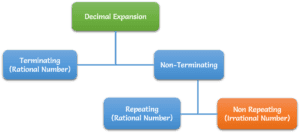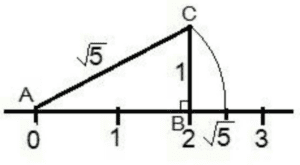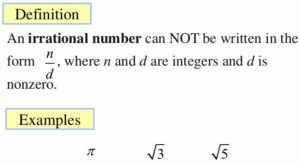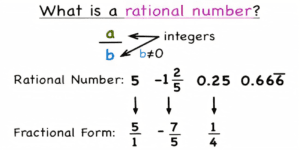
In this article, we will learn, How to convert a decimal number into a rational number? Earlier we discussed the decimal expansion of rational numbers. Before that, we will discuss all types of decimal numbers and their conversion to rational numbers.
There are three types of decimals
- Terminating
- Non-terminating and recurring
- Non-terminating and non-recurring
Non-terminating and non-recurring decimals can not be converted to a rational number of the p/q form.
to convert a decimal number into a rational number, we check if it is terminating or non-terminating.
How to convert a terminating decimal into a rational number
A terminating decimal has a fixed number of digits in its decimal expansion. They are easiest to convert to a rational number. Let us take some examples to understand it.
Example: Express the numbers as rational numbers.
(i) 0.15 (ii) 0.675 (iii) –25.6875
(i) $0.15=\frac{15}{100}$
$=\frac{15 \div 5}{100 \div 5}$
$=\frac{3}{20}$
(ii) $0.675=\frac{675}{1000}$
$=\frac{675 \div 25}{1000 \div 25} \Rightarrow=\frac{27}{40}$
(iii) $-25.6875=\frac{-256875}{10000}$
$=\frac{-256875 \div 625}{10000 \div 625}=\frac{-411}{16}$
How to convert a non-terminating and recurring decimal into a rational number
In this paragraph, we will learn How to convert a non-terminating and recurring decimal into a rational number. To do so we follow some steps:
Algorithm:
- Step-1: Take the decimal equal to x.
- Step-2: Write the number in decimal form by removing the bar. For example, write x =$0.\overline{6}$ as x = 0.666…. and x = $0.\overline{14}$ as x = 0.141414……
- Step-3: Note the number of digits having a bar on their top.
- Step-4: if the recurring number is 1 then multiply by 10; for a two-digit repetition, multiply by 100; for a three-digit repetition, multiply by 1000, and so on.
- Step-5: write the equation in terms of x.
- Step-6: solve the equation for x.
- Step-7: Write the rational number in its simplest form.
Example: Convert $0. \overline{6}$ into a rational number.
(i) Let $x=0 . \overline{6}$
then, $x=0.666 \ldots \ldots$
Here, we have only one repeating digit,
So, we multiply both sides of (i) by 10 to get
$10 \mathrm{x}=6.66 \ldots$
Subtracting (i) from (ii), we get
$10 \mathrm{x}-\mathrm{x}=(6.66 \ldots . . \mathrm{s})-(0.66 \ldots . .)$
$\Rightarrow 9 \mathrm{x}=6 \quad \Rightarrow \quad \mathrm{x}=\frac{6}{9}$
$\Rightarrow \quad x=\frac{2}{3} \quad$ Hence $0 . \overline{6}=\frac{2}{3}$
(ii) Let $x=0 . \overline{35}$
$\Rightarrow \mathrm{x}=0.353535 \ldots$
Here, we have two repeating digits after the decimal point.
So, we multiply the sides of (i) by $10^{2}=100$ to get
$$
100 \mathrm{x}=35.3535 \ldots \ldots
$$
Subtracting (i) from (ii), we get
$100 \mathrm{x}-\mathrm{x}=(35.3535 \ldots)-(0.3535 \ldots .)$
$\Rightarrow 99 \mathrm{x}=35$
$\Rightarrow \quad \mathrm{x}=\frac{35}{99}$
Hence, $0. \overline{35}=\frac{35}{99}$
(i) Let $x=5. \overline{2}$
$\Rightarrow \mathrm{x}=5.2222$
Multiplying both sides of (i) by 10, we get
$$
10 \mathrm{x}=52.222 \ldots \ldots
$$
Subtracting (i) from (ii), we get
$$
\begin{aligned}
& 10 \mathrm{x}-\mathrm{x}=(52.222 \ldots)-(5.222 \ldots) \\
\Rightarrow & 9 \mathrm{x}=47 \\
\Rightarrow & \mathrm{x}=\frac{47}{9}
\end{aligned}
$$
(ii) Let $x=23 . \overline{43}$
$\Rightarrow \mathrm{x}=23.434343 \ldots . .$
Multiplying both sides of (i) by 100, we get
$$
100 \mathrm{x}=2343.4343 \ldots \ldots .
$$
Subtracting (i) from (ii), we get
$$
\begin{aligned}
&100 \mathrm{x}-\mathrm{x}=(2343.4343 \ldots)-(23.43 \\
&\Rightarrow 99 \mathrm{x}=2320 \\
&\Rightarrow \mathrm{x}=\frac{2320}{99}
\end{aligned}
$$
(i) Let $x=0.3 \overline{2}$
Clearly, there is just one digit on the right side of the decimal point which is without bar. So, we multiply both sides of $x$ by 10
so that only the repeating decimal is left on the right side of the decimal point.
$\therefore 10 \mathrm{x}=3 . \overline{2}$
$\Rightarrow 10 \mathrm{x}=3+0 . \overline{2} \quad\left[\because 0 . \overline{2}=\frac{2}{9}\right]$
$\Rightarrow \quad 10 \mathrm{x}=3+\frac{2}{9}$
$\Rightarrow 10 \mathrm{x}=\frac{9 \times 3+2}{9} \Rightarrow 10 \mathrm{x}=\frac{29}{9}$
$\Rightarrow \mathrm{x}=\frac{29}{90}$
(ii) Let $\mathrm{x}=0.12 \overline{3}$
Clearly, there are two digits on the right side of the decimal point which are without a bar. So, we multiply both sides of $\mathrm{x}$ by $10^{2}=100$ so that only the repeating decimal is left on the right side of the decimal point.
$\therefore 100 \mathrm{x}=12 . \overline{3}$
$\Rightarrow 100 \mathrm{x}=12+0 . \overline{3}$
$\Rightarrow 100 \mathrm{x}=12+\frac{3}{9}$
$\Rightarrow 100 \mathrm{x}=\frac{12 \times 9+3}{9}$
$\Rightarrow 100 \mathrm{x}=\frac{108+3}{9}$
$\Rightarrow 100 \mathrm{x}=\frac{111}{9}$
$\Rightarrow \mathrm{x}=\frac{111}{900}=\frac{37}{300}$
(i) Let $\mathrm{x}=4.3 \overline{2}$
$\Rightarrow 10 \mathrm{x}=43 . \overline{2}$ $\text{Multiplying both sides of }$ $\mathrm{x}$ by 10
$\Rightarrow 10 \mathrm{x}=43+0 . \overline{2}$
$\Rightarrow 10 \mathrm{x}=43+\frac{2}{9}$
$\Rightarrow 10 \mathrm{x}=\frac{43 \times 9+2}{9}$
$\Rightarrow 10 \mathrm{x}=\frac{387+2}{9}$
$\Rightarrow 10 \mathrm{x}=\frac{389}{9}$
$\Rightarrow \quad \mathrm{x}=\frac{389}{90}$
(ii) Let $x=15.7 \overline{12}$. Then,
$$\begin{aligned}&10 \mathrm{x}=157 . \overline{12} \\
\Rightarrow & 10 \mathrm{x}=157+0 . \overline{12} \\
\Rightarrow & 10 \mathrm{x}=157+\frac{12}{99} \\
\Rightarrow & 10 \mathrm{x}=157+\frac{4}{33} \\
\Rightarrow & 10 \mathrm{x}=\frac{157 \times 33+4}{33} \\
\Rightarrow & 10 \mathrm{x}=\frac{5181+4}{33} \\
\Rightarrow & 10 \mathrm{x}=\frac{5185}{33} \Rightarrow \mathrm{x}=\frac{5185}{330}=\frac{1037}{66} \\
\end{aligned}
$$
Example 2: convert $5. \overline{001}$ into a rational number.
Solution Let us assume $5. \overline{001}$ is $\mathrm{x}$
$$
\begin{aligned}
x &=5. \overline{001} \\
1000 x &=5001 . \overline{001} \\
1000 x &=4996+5 . \overline{001} \\
1000 x &=4996+x \\
999 x &=4996 \\
x &=\frac{4996}{999} \\
5 . \overline{001} &=\frac{4996}{999}
\end{aligned}
$$
Example 3: convert $5. \overline{53}$ into a rational number.
Solution Let us assume $5. \overline{53}$ is $x$
$$
\begin{aligned}
x &=5. \overline{53} \\
100 x &=553 . \overline{53} \\
100 x &=548+5 . \overline{53} \\
100 x &=548+x \\
99 x &=548 \\
x &=\frac{548}{99} \\
5 . \overline{53} &=\frac{548}{99}
\end{aligned}
$$
Example 3: convert 5.53 into a rational number.
Solution Let us assume $5. \overline{53}$ is $\mathrm{x}$
$$
\begin{aligned}
x &=5. \overline{53} \\
100 x &=553 . \overline{53} \\
100 x &=548+5 \\
100 x &=548+x \\
99 x &=548 \\
x &=\frac{548}{99} \\
5 . \overline{53} &=\frac{548}{99}
\end{aligned}
$$
Example 4: convert $0. \overline{123}$ into a rational number.
Solution Let us assume $0. \overline{123}$ is $\mathrm{x}$
$$
\begin{aligned}
x &=0 . \overline{123} \\
1000 x &=123 . \overline{123} \\
1000 x &=123+0 . \overline{123} \\
1000 x &=123+x \\
999 x &=123 \\
x &=\frac{123}{999} \\
0 . \overline{123} &=\frac{123}{99}
\end{aligned}
$$
Tutorial video to watch about how to convert the decimal numbers into rational numbers?
Conclusion
To convert a decimal expression into a rational number, we assume the number to be x. and then manipulate it through some equations to obtain the rational form of a decimal.
Frequently Asked Questions – FAQs
Does every decimal expression have a rational form?
No, only terminating decimals and non-terminating and repeating decimals have a rational form. Decimal expressions that are non-terminating and non-repeating are irrational numbers.
How to know the multiplication number of x?
If the recurring digit is 1, then multiply x by 10, if 2 then 100, if 3 then 1000, and so on.
Thanks for reading. Feel free to ask your doubts in the comments below. don’t let your curiosity end here read more on the Laws Of Nature!






